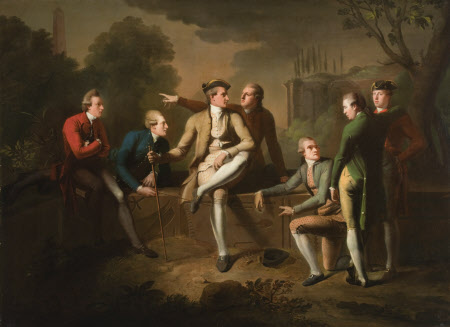The Ham House Roman Conversation Piece
attributed to John Brown (Edinburgh 1752 - Leith 1787)
Category
Art / Oil paintings
Date
1773
Materials
Oil on canvas
Measurements
991 x 889 mm (39 x 53 in)
Place of origin
Rome
Order this imageCollection
Ham House, Surrey
NT 1139726
Caption
In the 18th century, the Grand Tour was considered to be the best way to complete a gentleman's education. Young aristocrats travelled to the cities of Europe, usually beginning in Paris and then moving south to Spain or Italy where they visited the ancient classical sites. In this group portrait, The Hon. John Tollemache (1750-1777), son of the 4th Earl of Dysart of Ham House poses with his friends. The setting with classical ruins is indicative of their new learning.
Summary
Oil painting on canvas, The Ham House Roman Conversation Piece (Gentlemen on the Grand Tour), attributed to John Brown (Edinburgh 1752 - Leith 1787), 1773. Previously attributed to Philip Wickstead (fl.1763 - Jamaica 1790). The gentlemen are John Corbet (1751 - 1817), The Hon. John Tollemache (1750 - 1777), John Chetwynd-Talbot, later 1st Earl Talbot (1750 - 1793), James Byres (1734 - 1817), Sir John Rous, 6th Bt, and 1st Earl of Stradbroke (1750 - 1827), John Staples (1736 - 1820), William McDowall. Seven full-length portraits of a group of young gentleman in a classical setting with trees and ruins, a half-buired Egyptian obelisk. Another version was at Sundorne Castle, Shropshire which had descended in the Corbet family until sold at auction in 1981.
Provenance
By descent through the family of Tollemache earls of Dysart; in 1911 catalogue; and thence by descent until acquired in 1948 by HM Government when Sir Lyonel, 4th Bt (1854 – 1952) and Sir Cecil Tollemache, 5th Bt (1886 – 1969) presented Ham House to the National Trust, and entrusted to the care of the Victoria & Albert Museum, until 1990, when returned to the care of the National Trust, and to which ownership was transferred in 2002
Credit line
Ham House, The Dysart Collection (purchased by HM Government in 1948 and transferred to the National Trust in 2002)
Marks and inscriptions
Recto: On frame, in black on gold: GROUP OF GENTLEMEN ON THE GRAND TOUR / ATTRIBUTED TO PHILLIP WICKSTEAD (active 1763–c.1790)
Makers and roles
attributed to John Brown (Edinburgh 1752 - Leith 1787) , artist previously catalogued as attributed to Philip Wickstead (fl.1763 - 1786) (d. Jamaica 1790), artist previously catalogued as attributed to Johann Zoffany, RA (Frankfurt am Main 1733 - Kew 1810), artist previously catalogued as attributed to Richard Brompton (c.1734 - St Petersburg 1783), artist previously catalogued as attributed to British (English) School, artist
References
Laing 2009 Alastair Laing, “John Brown as a painter?” Apollo, suppl. Historic Houses and Collections Annual April 2009, pp.12-17, Regrettably, the known portraits of Lord Rous show him as too much older to be usefully compared with the likeness of the man seated in the group on the right of the picture”; and, n.32: “The earlier portrait of Rous, probably done around the time of that of Beechey’s of his second wife (i.e. c.1796), is known only from Henry Bone’s squared-up outline drawing of it for his lost enamel miniature (cf. Richard Walker, ‘Henry Bone’s pencil drawings in the National Portrait Gallery’, The Sixty-First Volume of the Walpole Society, 1999, no. 439, p.342 & fig. 148). Sir William Beechey’s later portrait of him, three-quarter length, in peer’s robes, was painted in 1811, and scraped in mezzotint by Charles Turner in the same year Ford 1974 Brinsley Ford, ‘James Byres, Principal Antiquarian for the English Visitors to Rome’. Apollo XCIX, June 1974, pp.446–61




